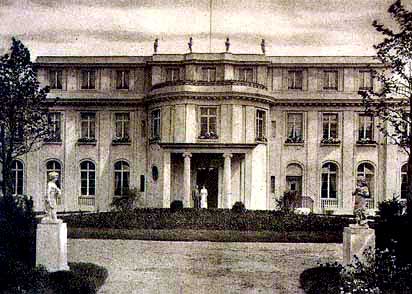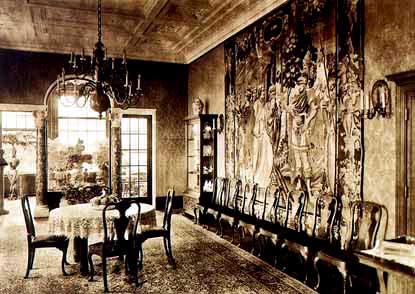History of the Wannsee villa  The first photograph above shows the original owners, Ernst and Margarete Marlier, standing in front of the villa in 1916. Note the two small trees on either side of the driveway which have now grown up until they almost hide the house. The photograph immediately above shows the dining room, where the Wannsee Conference was held, as it looked in 1922. At the time of the conference in January 1942, the room was probably furnished much like this. Now the former conference room has been stripped of its Queen Ann chairs, Oriental rug, chandelier, and wall tapestry, and only a glass table and 15 stools are in the room. A special exhibit about the history of the building is located in the Wintergarten, the sun room next to the dining room. The following information is given in the exhibit: The villa was built in 1914-15 by the merchant, factory owner and Privy Commercial Councilor Ernst Marlier. Paul O.A. Baumgarten, a student of Alfred Messels, designed both the building, which contained 1,500 square meters of living space, and the large garden, which measured 30,000 square meters and was nearly a park. Baumgarten had already built several villas nearby, among them one for the painter Max Liebermann in 1909. Ernst Marlier and his wife Margarete lived at Wannsee for only a few years. He sold the house and premises on September 6, 1921, to a firm belonging to the industrialist Friedrich Minoux. Under the ownership of Minoux, the first important conference was held at the villa when, according to the museum, "On February 21, 1923, he mediated an unsuccessful discussion in the villa between the chief of the army command, General Hans von Seeckt, and the former quartermaster general, Erich Ludendorff, on possible measures to be taken against the occupation of the Ruhr region." The Ruhr region was an important industrial section of Germany that had large coal deposits. After World War I, Germany was forced to pay reparations to the French; when they could not make the payments, France occupied the Ruhr. The Treaty of Versailles had also forbidden Germany to have an army of more than 100,000 soldiers, so there was very little they could do to defend themselves. According to the museum, Minoux was also involved in Hitler's failed Putsch on November 9, 1923. On that date, which was the 5th anniversary of the overthrow of the 500-year old Hohenzollern dynasty of Germany by the Jewish-led Social Democrats, Hitler made an attempt to overthrow the democratic Weimar Republic. According to the museum, "On October 25, 1923, he met with Ludendorff and Hitler in Munich, but they reached no agreement on a common plan for the attempted Putsch of November 9, 1923." The drawing below shows the layout of the ground floor of the house. On either side of the circular entrance room, there are several small rooms which are closed off and are not a part of the Museum. Notice that the two small rooms to the right of the circular foyer can only be reached by an outside door. The rest of the ground-floor rooms have large panels on the walls with text about the Nazi era and the Holocaust, along with a collection of pictures related to the evacuation of the Jews, which was planned at the Wannsee Conference. There are documents included in the exhibit, but no Holocaust artifacts or artwork.  In 1940, Minoux was arrested for fraud and embezzlement in his business dealings. In November 1940, he sold the villa to the Nordhav SS Foundation set up by Reinhard von Heydrich. According to the museum, "The purpose of the foundation was to build and maintain vacation resorts for the SS Security Service (SD)." Heydrich wanted to use the Wannsee villa for "official functions and as a holiday resort." The museum says that "Friedrich Minoux was not forced to sell. The Nordhav Foundation paid him 1.95 million Reichsmark, the market price." The sale included part of the furnishings and paintings. On November 15, 1941, an Order Bulletin of the Chief of Security Police and SD described the Wannsee villa as follows: What does the guest house offer? Completely renovated guest rooms, communal rooms such as music rooms, game rooms (billiards), a large hall and winter garden, terraces facing the Wannsee, central heating, running water and all the amenities. After Heydrich's death, the house was sold on February 4, 1943 to the Reich Security Main Office (RSHA) for the same price it had paid to Minoux. The stated purpose was the preservation of the building as a recreation center for men and officers of the Security Police. The following is a quote from a Museum display: In 1945, the house was inhabited first by Soviet Russian marines, thereafter by American officers. In 1947, the August Bebel Institute of the Social Democratic Party turned it into a residential adult education center, and from 1952 until 1988, the building served as a school hostel for the district of Neuköln. It was through the efforts of Josef Wulf that the villa became known as the site of the Conference where the genocide of the Jews was planned. In 1965, Wulf first proposed that a place be established at the villa for the study of National Socialism and its consequences. Nahum Goldmann, the president of the World Jewish Congress, offered substantial financial support for a document center to be established in the villa, but the German government was not willing to make the building available to the Jews. According to the museum, Josef Wulf committed suicide in 1974 after years of unsuccessful negotiations with the German government. It was not until two decades later, on the 50ieth anniversary of the Conference, that the house was formally inaugurated as a memorial and educational site for the Holocaust. Museum at WannseeWannsee ConferenceConference roomHomeThis page was last updated on March 17, 2009 |